End-of-line automation integration allows manufacturers to streamline production, reduce manual handling, and maintain consistent output quality. This provides a multitude of benefits, including greater efficiency, improved safety, and scalable systems that are able to grow with demand.
Integrating automation into an established production line can be implemented with minimal disruption by taking a structured step-by-step approach.
Key Steps for Successful End-of-Line Automation Integration
- Confirm product sizes and weights
Accurate product information is the foundation of successful end-of-line automation integration. Before specifying equipment, it’s essential to confirm the full range of product sizes and weights. Even small variations can affect how items are gripped, moved, or stacked. Pre-production trials will ensure that the system is configured correctly and can handle every product reliably, avoiding costly adjustments later in the project.
- Define pallet patterns
Palletising systems need clear stacking instructions. Some clients supply existing pallet pattern data, while in other cases, our team will capture photographs or produce CAD drawings to design the best arrangement. Establishing these patterns early ensures stable, efficient pallet loads that meet transport and storage requirements.
- Assess production speeds
Line speed is a critical factor in choosing and configuring automation equipment. The system must keep up with current throughput, but it should also be designed with future growth in mind. Factoring in potential speed increases at this stage ensures the investment remains suitable for years to come.
- Plan pallet loading and unloading
The handling of empty and full pallets is often overlooked, yet it has a major impact on efficiency. Options include conveyors, pallet de-stackers, or fully automated pallet handling, depending on available space and budget. Considering this step early ensures pallets move smoothly through the process without creating bottlenecks.
- Create accurate layout drawings
Automation equipment must fit seamlessly into the production environment. While clients may provide layout drawings, our engineers also carry out detailed site surveys to confirm dimensions. Precise measurements are vital to avoid installation delays and to ensure equipment integrates with existing lines and infrastructure.
- Identify access issues and obstacles
Every site has practical constraints such as doorways, support columns, low ceilings, or operator walkways. Identifying these in advance allows the system to be designed around them, reducing the risk of unexpected challenges during installation and ensuring safe, efficient access for staff.
Choosing the right end-of-line automation machines
Selecting the correct automation equipment is crucial to ensure reliable operation, efficiency, and future scalability. Every production environment is different, and there is no one-size-fits-all solution. PALpack offers a wide range of palletising systems to meet a wide range of requirements.
Contact PALpack today to discuss your requirements and find the best end-of-line automation solution for your business.




